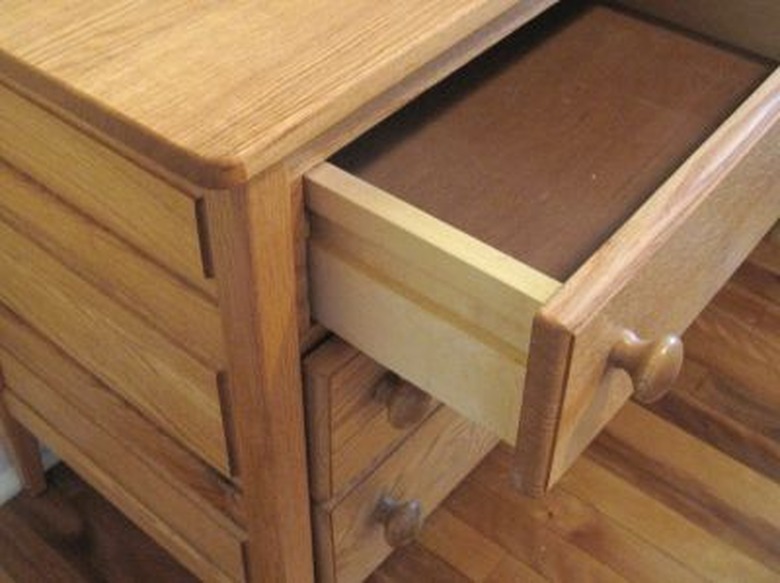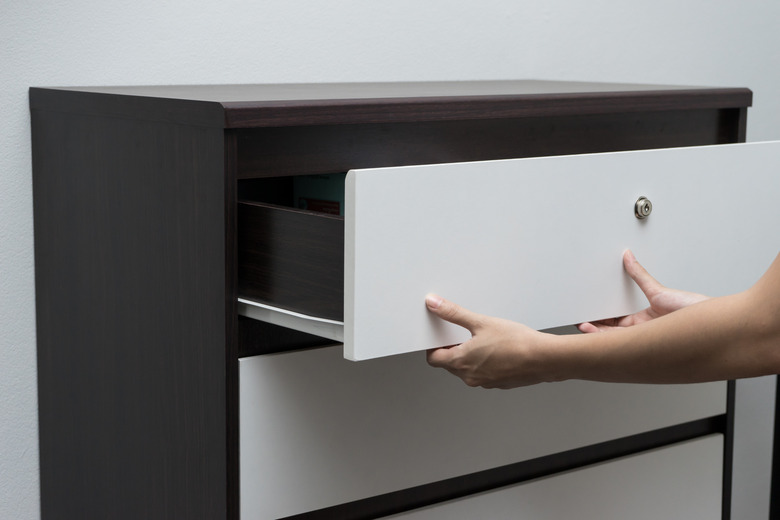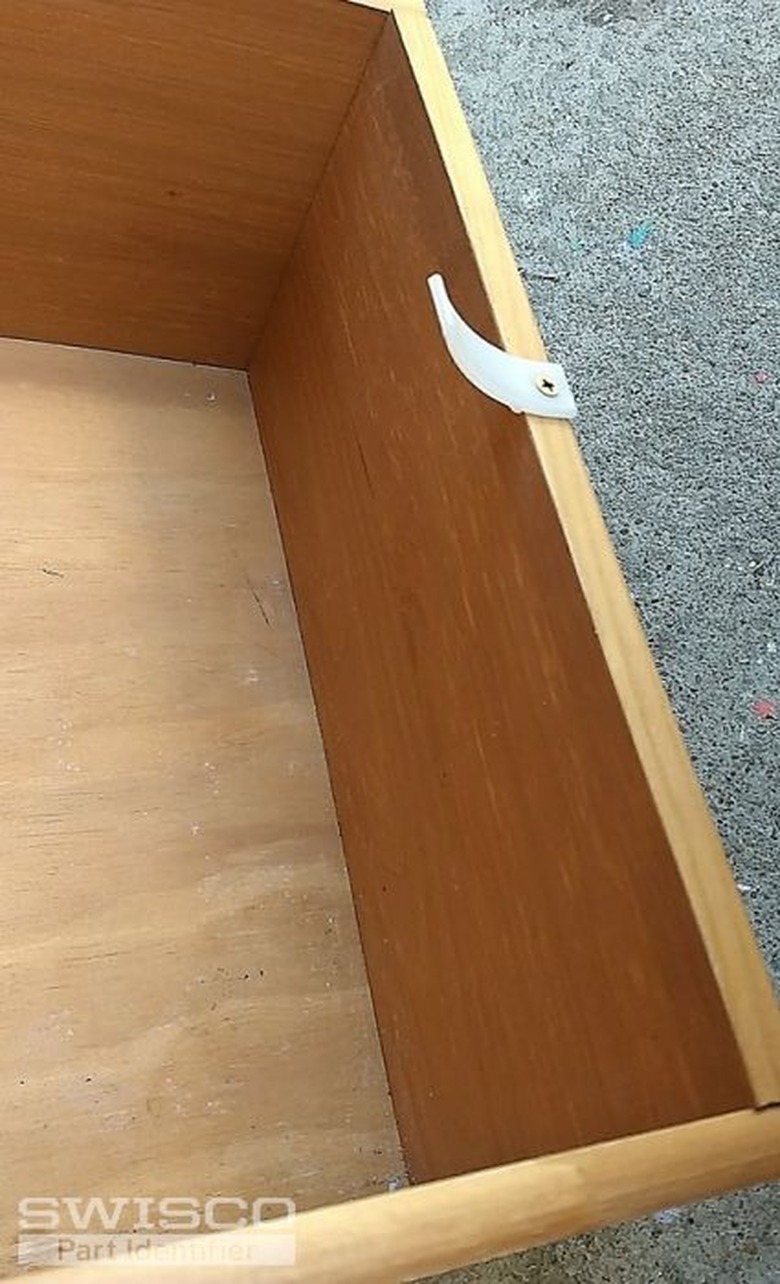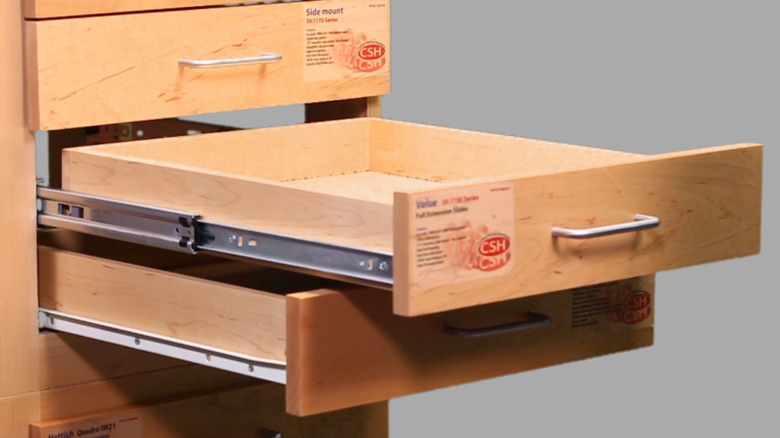How To Remove Drawers With Plastic Stops
The little plastic stops on the drawers in your kitchen and bathroom cabinets and in the dresser in your bedroom are there for your safety. If a drawer is full, and it doesn't have stops, you can inadvertently pull it out too far, and the contents can spill onto the floor. Worse yet, if the drawer is on the bottom of a dresser, the whole dresser can tip over because of the sudden shift in weight.
Drawer stops can take a number of forms, and some manufacturers, such as Broyhill, have proprietary designs. The little plastic tabs you often find on the back or side of cabinet and dresser drawers are more generic. These plastic tabs aren't beefy, but they will effectively prevent removal of the drawer. You'll typically find them on drawers that feature wooden glides or metal runners that hook onto plastic rollers attached to the opening in the cabinet.
The general procedure for removing drawers that have plastic stops isn't difficult, and it usually doesn't require tools, but in some cases, you might need a screwdriver to loosen or remove the stops so you can get the drawer out.
Procedure for Removing the Drawer
Procedure for Removing the Drawer
Start by verifying that the drawer does indeed have plastic stops. Your main clue is that you can open the drawer almost all the way, but not quite. If the drawer opens only three-quarters of the way, the stops are probably built into the metal glides on the side.
1. Lighten the Load
If the drawer is full, remove some its contents. Ideally, the drawer should be completely empty, but a partially full drawer can also be removed.
2. Start at the Top
If you're removing all the drawers from a dresser or cabinet, start with the one on the top and work your way down to prevent weight imbalance and tipping.
3. Pull the Drawer Out as Far as It Will Go
The stop will prevent you from pulling the drawer past a certain point. Don't try to force the drawer past this point. You might be successful in getting it out, but if you are, you'll break the stop.
4. Back the Drawer Up and Lift the Front
Disengage the stop from whatever it's bumping by backing up the drawer by a small amount. Now, lift the front of the drawer several inches, which will pivot the drawer box enough to slightly lower the stop so it can clear the cabinet facing.
5. Support the Back of the Drawer and Pull
Place one hand under the drawer near the back to support it, then pull gently. Once the stop clears the facing, and the drawer is free, transfer both hands to the sides of the drawer and lift it out of the cabinet.
Tip
If the drawer has metal glides that slide along plastic wheels, you'll have to work the wheels along the curved section at the back of the glides as you lift the front and pull. This may take a little extra wiggling, but you can usually remove the drawer with little effort.
You May Have to Loosen or Remove the Stops
You May Have to Loosen or Remove the Stops
Older cabinet and dresser drawers often are not manufacturered with stops, and it isn't unusual for intrepid handypersons to add them after the fact. In this case, the stops are usually screwed to the the back of the drawer and extend upward to strike the back side of the cabinet facing and prevent the drawer from falling out. These are sometimes installed while the drawer is in the cabinet, the only way to remove the drawer may be to move the stops out of the way or take them out completely.
To do this, open the drawer far enough to allow you to reach inside with a screwdriver. Locate each stop, using a flashlight or your sense of touch, then try bending it or rotating it. You may have to unscrew the screw holding it to the drawer. There may be one stop or two per drawer, and each one is usually held by a single screw. When you loosen the screw sufficiently, you can usually rotate the stop downward and out of the way so you can remove the drawer. If the stop won't rotate, back the screw out all the way and take the stop off.
Removing Cabinet Drawers That Have Safety Locks
Removing Cabinet Drawers That Have Safety Locks
The telescoping glides on some drawers (such as file cabinets and desks) have built-in safety-lock stops, and unless you know how to release these, removing the drawer is virtually impossible. Manufacturers don't all employ the same stop mechanism, but a generic procedure will work for most of them.
- Open the drawer as far as it will go.
- Slide one hand along the glide on each side of the drawer until you feel the lock lever at the junction of the drawer glide and the cabinet runner. You should feel a movable tab at each junction.
- Depress both tabs at the same time while simultaneously pulling the drawer forward. It should slip past the lever, and you can then lift it away from the cabinet.
Tip
It's important to depress both tabs at the same time. If you depress one and not the other, the drawer may tip and spill its contents onto the floor.



